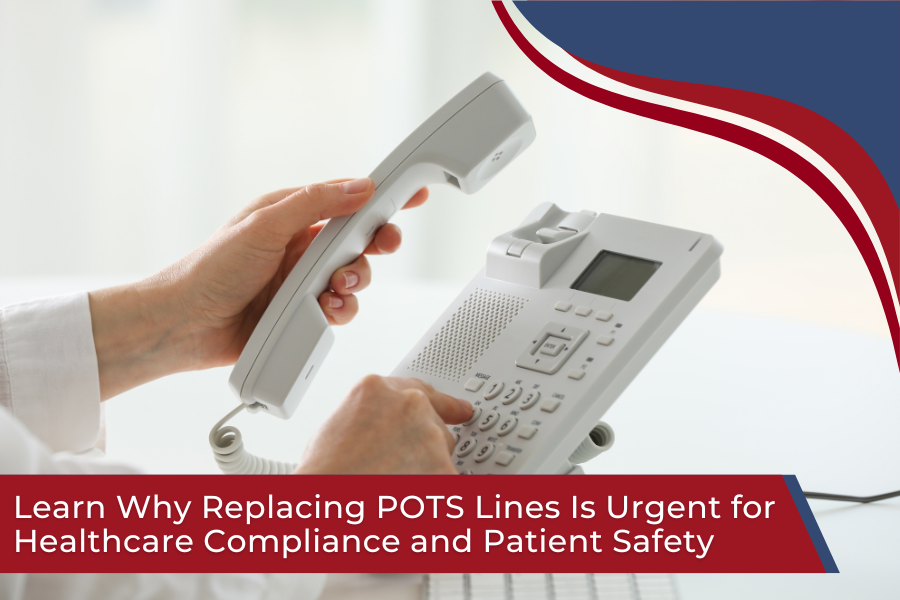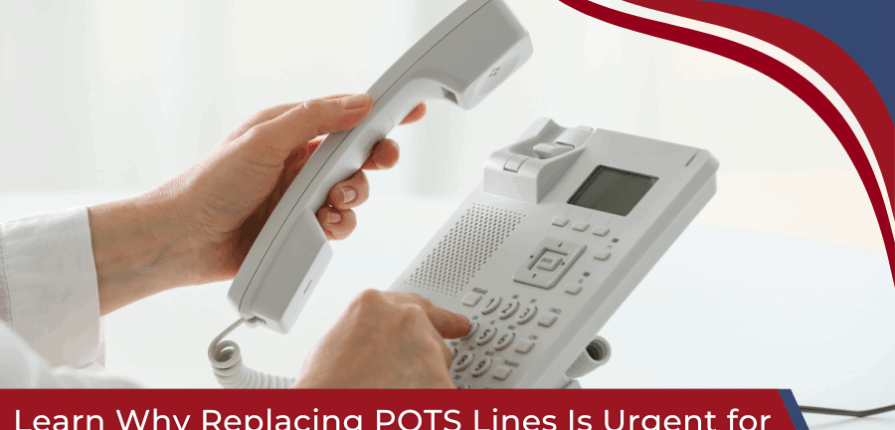
Reliable, uninterrupted communication is the backbone of healthcare life-safety systems. From fire alarms to security panels and elevator emergency phones, every second counts when an alert must reach first responders. For decades, these signals traveled over Plain Old Telephone Service (POTS) lines—copper-based analog phone connections that once formed the backbone of American communication.
But times have changed. Telecom providers are retiring their copper networks, and POTS lines are rapidly disappearing. This shift is not just a technical inconvenience for healthcare facilities—it’s a direct threat to patient safety, regulatory compliance, and operational continuity. The solution? ProConnect Max from Protex Central, a robust, code-compliant platform that secures uninterrupted communication for all your life-safety systems.
What Is a POTS Line?
POTS, or Plain Old Telephone Service, refers to the traditional analog phone lines that have been in use since the late 1800s. These copper wires are simple and have powered everything from rotary phones to fax machines. In healthcare, POTS lines have long been the standard for connecting:
- Fire alarm control panels (FACPs) to central monitoring stations
- Security alarm systems to dispatch centers
- Elevator emergency phones to 24/7 response teams
- Nurse call and duress systems in some legacy installations
POTS lines transmit signals by converting voice or data into analog electrical pulses. Their simplicity was once their strength—no internet required, no complex networking, just a direct, physical connection.
Why Are POTS Lines Being Phased Out?
The telecommunications landscape has shifted dramatically. Fiber optics, cellular networks, and broadband IP (Internet Protocol) connections now dominate. Maintaining old copper infrastructure is costly, inefficient, and increasingly unreliable. Major telecom providers have announced the end of support for POTS, meaning:
- No new installations or repairs for copper lines
- Increased monthly costs for legacy service
- Higher risk of outages, slowdowns, or total service loss
For healthcare facilities, this is a critical issue. Life-safety systems must have reliable, supervised communication paths to meet code and accreditation requirements. A single missed alarm signal could have catastrophic consequences.
Why Is POTS Replacement Urgent for Healthcare Facilities?
Healthcare organizations face unique pressures when it comes to communication reliability:
- Patient Safety: Fire alarms, elevator phones, and security systems must function without fail—even during power outages, storms, or network disruptions.
- Regulatory Compliance: NFPA 72, UL 864, CMS, and Joint Commission standards require supervised, redundant, and tested communication channels for all life-safety systems.
- Operational Continuity: Outages can halt admissions, delay care, or trigger costly evacuations.
The phase-out of POTS is not a distant possibility—it’s happening now. Facilities that delay replacement risk failed inspections, fines, and, most importantly, jeopardized patient safety.
What Is ProConnect Max?
ProConnect Max is a next-generation communication platform designed to replace POTS lines in healthcare and other critical environments. Developed by Protex Central, ProConnect Max leverages 5G wireless and IP (Ethernet/Broadband) connectivity to deliver secure, dual-path alarm communication for:
- Fire alarm control panels
- Security and intrusion alarms
- Elevator emergency phones
- Panic/duress buttons
- Other critical signaling devices
Key Features:
- Dual-Path Redundancy: Simultaneous cellular (5G/LTE) and IP transmission. If one path fails, the other ensures uninterrupted signal delivery.
- Battery Backup: Maintains operation for extended periods during power outages.
- UL 864/NFPA 72 Compliance: Certified for fire alarm communication, meeting the highest standards in life-safety signaling.
- Remote Monitoring: 24/7 signal verification and real-time alerts via Protex Central’s monitoring center.
- Seamless Integration: Connects directly to existing alarm panels—no need for costly panel replacements.
The Transition Process: Upgrading from POTS to ProConnect Max
Transitioning from POTS to ProConnect Max is a structured, minimally disruptive process. Here’s how Protex Central manages your upgrade:
1. Comprehensive Assessment
Our team conducts a thorough audit of your facility’s communication infrastructure, identifying every device and system that relies on POTS lines. This includes fire alarms, security panels, elevator phones, and any other analog-dependent endpoints.
2. System Design and Planning
We design a custom solution for your facility, selecting the optimal mix of cellular and IP pathways. Our engineers ensure signal coverage, redundancy, and compliance with all applicable codes.
3. Installation
ProConnect Max communicators are installed alongside your existing panels. Most systems connect via standard RJ11 (phone) or Ethernet ports, allowing for rapid deployment without rewiring or major construction. Installations are scheduled to minimize disruption to patient care.
4. Testing and Validation
Every connection is tested for signal strength, failover capability, and end-to-end communication with the monitoring center. We simulate outages to verify redundancy and document all test results.
5. Documentation and Training
You receive compliance documentation for NFPA, UL, CMS, and Joint Commission surveys. We train your staff on system operation, troubleshooting, and emergency protocols.
6. Ongoing Monitoring and Support
Protex Central provides 24/7 monitoring, annual inspections, and priority service for any issues. Our local experts are always available for technical support or compliance questions.
Compliance Benefits: Meeting and Exceeding Healthcare Standards
|
Requirement |
ProConnect Max Solution |
|
Supervised Communication Path |
Dual-path (5G/IP) with real-time monitoring |
|
Signal Delivery Verification |
Automated daily “heartbeat” and event reporting |
|
Backup Power |
24+ hour battery backup; generator compatibility |
|
UL/NFPA Certification |
UL 864 Listed, NFPA 72 Compliant |
|
Regulatory Documentation |
Full reports for CMS, Joint Commission, local AHJs |
ProConnect Max is designed from the ground up to meet the most stringent requirements in healthcare. You’ll be ready for any survey, audit, or emergency.
Why Healthcare Facilities Choose Protex Central
- Local Expertise: Our Nebraska and Iowa-based teams understand regional codes, weather risks, and the operational realities of healthcare.
- Turnkey Service: From permitting to carrier agreements, we handle every detail of your transition.
- Continuous Support: 24/7 monitoring, rapid repairs, and ongoing compliance guidance.
- Future-Ready: As technology evolves, ProConnect Max will keep your facility connected and compliant.
Frequently Asked Questions
Q: Can ProConnect Max support multiple alarm types on one device?
A: Yes. Fire, security, elevator, and panic systems can all connect to a single ProConnect Max communicator, streamlining management and reducing costs.
Q: What happens if both cellular and IP fail?
A: ProConnect Max’s battery backup maintains operation, and the system automatically retries both paths. Alerts are sent to the monitoring center if communication is lost.
Q: How long does installation take?
A: Most upgrades are completed in a single day, without disrupting patient care or critical operations.
POTs Replacement
POTS lines are vanishing, but your facility’s need for reliable, code-compliant life-safety communication is greater than ever. ProConnect Max from Protex Central delivers a seamless, future-ready solution that protects patients, staff, and your compliance record—no matter what tomorrow brings.
Don’t wait for a failed inspection or a critical outage. Protex Central’s ProConnect Max ensures your fire alarms, security systems, and elevator phones communicate reliably—without POTS lines. Contact us at (800) 274-0888 for a free assessment and expert transition plan. Secure your facility’s life-safety communications today and keep your patients safe, every minute of every day.



Leave a Reply
You must be logged in to post a comment.